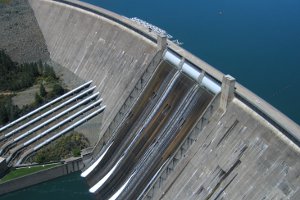That may not be a typical reaction, but climatologist Kelly Redmond says it reveals a lot about how we think about risk. "It has to do with how we describe rare things. We spend societally an enormous amount of resources and time and attention guarding against the very worst possibilities."
[jwplayer config="QUEST Audio Player" skin="http://ww2.kqed.org/quest/wp-content/themes/quest/glow.zip" file="http://www.kqed.org/.stream/anon/radio/quest/2011/05/2011-05-16-quest.mp3" ]
Listen to the QUEST radio story Insuring for Extreme Weather
You've probably heard of the "100-year flood." That's a flood so severe that it has a one in one hundred chance of happening every year. But how do we know that?
"About the only way we can get at how rare a rare thing is is by looking at a past record," says Redmond. So for floods, government agencies look into the historical record to see when floods happened in the past. They use that record to predict future flood risk.
But this relies on a very basic assumption. According to Redmond, the assumption is that the statistics of the future will look like the statistics of the past.
There's a fancy term for this – it's called stationarity. But there's a problem.
"What we don't know but what we suspect with changes in climate is that those statistics, especially about rare things, may change," says Redmond.
The US is already warming. Climate models show that western states could see more extreme weather as the climate continues to change. So, Redmond says, chances are good the future won't look like the recent past.
Jeanine Jones of the California Department Water of Resources agrees, saying "a lot of California's existing infrastructure was designed on assumptions that are no longer valid."
History of Water Forecasting in the West
Jones says using the past as a guide for the future is a huge part of water planning and building codes. The idea was first adopted in the 1940s and 50s, when dams and infrastructure were built at record speed in western states.
"Congress was looking at all these water development plans coming in from the Corps of Engineers and the Bureau of Reclamation and wanting a common standard to compare all the projects," says Jones.
So they forecasted flood risk and water supply by looking at historical data. "But they had very short data records. Maybe they only measured records of 20 years, 50 years. And that's not really very long," Jones says.
Today, everything from building codes to home insurance is based on this short window of data. And so is another critical forecast.
During the winter, surveyors measure the Sierra Nevada snow pack every month, so they can crunch the numbers and predict the year's water supply.
"It is very widely used by reservoir operators, by water agencies, by farmers who are looking at what are my chances for having a full water supply," says Jones.
But climate models show that more precipitation will fall as rain in California, instead of snow. And that means spring runoff could behave very differently. "At some point, conditions will change enough that we've reached a tipping point where those statistical approaches really aren't valid anymore," Jones says.
An accurate water forecast is crucial to California's economy. So Jones says water officials are looking at using computer models to forecast spring runoff.
But when it comes to updating flood risk and building codes to reflect climate change, Kelly Redmond says that could take decades. "We have to get a buy in from the engineering community, the city planners. Because there's so much expense to goes into building a bridge or a culvert or a building."
A New Breed of Insurance Company
There is one industry that's taking note of climate change – insurance.
"The increased variability in climate is going to start to dramatically affect the profits of corporations worldwide," says David Friedberg, CEO of San Francisco-based Weatherbill.
Weatherbill is something of a next generation insurance company. They start with computer models that simulate weather and climate patterns. "We then use those sorts of models to determine what sort of price we should charge for certain weather events occurring," says Friedberg.
Weatherbill works mostly with farmers, insuring them against extreme weather for between 40 and 400 dollars an acre. "There's a range of things that can occur and that range is certainly widening. And as a result we should start to charge more for those sorts of events when we're insuring them."
Friedberg says this kind of insurance makes sense to a lot of farmers they work with, who are already noticing changing weather patterns. Investor Vinod Kholsa and Google have also noticed and put millions into the company. They're betting new software will be the answer when today's methods no longer work.
37.7749295 -122.4194155
 Water forecasting could be thrown off by a changing climate. Credit: Craig Miller
Water forecasting could be thrown off by a changing climate. Credit: Craig Miller